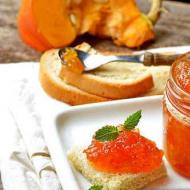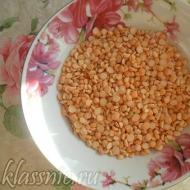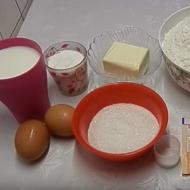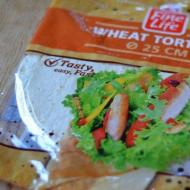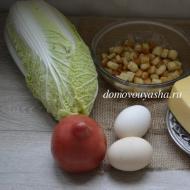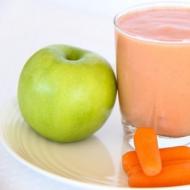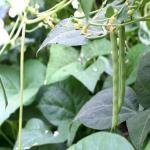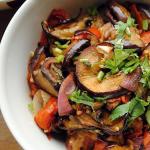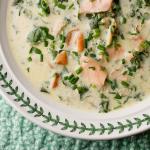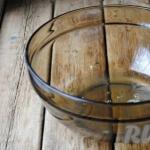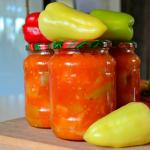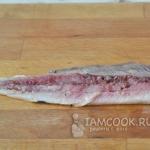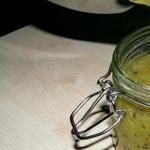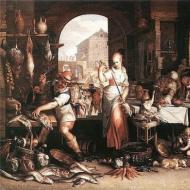
Dishes and side dishes made from boiled vegetables. Green dip for vegetables
For poaching, carrots, turnips, pumpkin, zucchini, cabbage, tomatoes, spinach, and sorrel are used. Allow individual types of vegetables or mixtures thereof. Simmer vegetables in their own juice or with a small amount of liquid (water or broth) with the addition of butter. The liquid remaining after poaching is not drained, but used together with vegetables. The lid is closed during poaching. The loss of nutrients during poaching is significantly less than during cooking.
Peeled vegetables are cut into cubes, slices, strips or cubes. For poaching, vegetables are placed in a layer of no more than 20 cm or in one row (cabbage). Vegetables (pumpkin, zucchini, tomatoes, spinach) that easily release moisture are simmered without liquid. Spinach should not be mixed with sorrel as it becomes tough and changes color. Steamed vegetables are seasoned with butter or milk sauce. Used as an independent dish and as a side dish.
Poached carrots. Carrots are cut into medium cubes, slices or cubes, put in a bowl, pour in a little broth or water (0.2–0.3 liters per 1 kg of vegetables), add butter or margarine, bring to a boil, add salt, cover with a lid and simmer until ready.
When leaving, the poached carrots are placed in a lamb or portioned frying pan, with a piece of butter on top.
When preparing carrots with sauce, the poached carrots are seasoned with a medium-thick milk sauce, sugar is added and heated. Can be served with wheat bread croutons.
Carrots 271, table margarine 5, sugar 3, butter 10 or sauce 50. Yield 210/250.
Carrots with green peas in milk sauce. Carrots are cut into small cubes and simmered until tender with the addition of margarine. Quick-frozen green peas are placed in boiling salted water, brought to a boil and cooked for 3-5 minutes, canned peas are heated in the broth and drained in a colander. Poached carrots are combined with prepared green peas, poured with milk sauce, salt is added and heated.
When leaving, put it in a lamb or portioned frying pan and pour over margarine. Can be served with croutons.
Carrots 136, table margarine 10, canned green peas 77 or frozen green peas 54, sauce 75, table margarine 5. Yield 230.
White cabbage with sauce. White cabbage is cut into slices or individual leaves are scalded and rolled into balls, placed in a bowl in one row, a small amount of broth or water is poured, butter or margarine and salt are added, covered with a lid and simmered until tender.
When on vacation, place it in a lamb, portioned frying pan or plate, pour over milk sauce, or sour cream, or sour cream with tomato. If cabbage is used as a side dish, it is cut into pieces.
Vegetables poached in milk sauce. Carrots, turnips, pumpkin or zucchini are cut into cubes or slices, cauliflower is divided into small inflorescences, and white cabbage is cut into checkers. Each type of vegetable is cooked separately. Canned green peas are heated in their own juice. Combine the prepared vegetables, season with medium-thick milk sauce, add sugar and salt and boil for 1–2 minutes. Instead of milk sauce, you can use sour cream sauce.
When leaving, put it in a lamb or portioned frying pan and sprinkle with herbs. You can put a piece of butter and serve with croutons.
Carrots 63, turnips 44, pumpkin 51 or zucchini 57, canned green peas 31, table margarine 10, sugar 2, sauce 75. Yield 200.
Boiled potatoes. Peeled potatoes (uniform in size) are placed in boiling salted water, quickly brought to a boil and cooked at low simmer in a container covered with a lid.
Per serving: new potatoes 313 g, butter 15 g or sour cream 30 g.
The broth is drained from the finished potatoes, the potatoes are dried and placed in a crumble or on a plate. Season with oil and sprinkle with chopped dill.
Note. To serve as an independent dish, it is advisable to use new potatoes.
To serve as a side dish, potatoes are peeled into a barrel or pear and boiled as described above. Boiled potatoes are also stored in broth. Potatoes are served with boiled, poached and fried fish, boiled beef and natural herring.
Potatoes boiled in milk. Raw potatoes are cut into medium-sized cubes and scalded with boiling water. The water is drained, poured with hot milk and cooked until tender. Then the potatoes are seasoned with cold flour sauté and boiled for another 5-7 minutes. Store on the steam table for no more than 2 hours.
The potatoes are served for entrecote.
Cauliflower. Place the prepared cauliflower in boiling salted water, quickly bring to a boil and cook until tender in a sealed container at a low simmer. Readiness is determined by piercing a chef's needle into the thickened part of the head of cabbage near the stalk.
The cooked cabbage is lightly dried, placed on a plate and sprinkled with cracker or hollandaise sauce. When serving in portions, the cabbage is wrapped in a linen napkin (to remove moisture and keep it hot), placed on a dish and decorated with sprigs of herbs. Cracker or Dutch sauce is served separately.
To serve as a side dish, prepared cabbage is disassembled into small inflorescences (buds), placed in boiling salted water and cooked until tender, after which it is removed from the broth and stored in the refrigerator on a baking sheet. When stored in broth, cabbage darkens. Before leaving, the cabbage is heated in cabbage broth, then taken out and placed on a dish or plate and poured with butter or cracker sauce. This side dish is served with meat and poultry dishes.
Brussels sprouts. To prepare the side dish, put the cobs in salted boiling water, cook until tender, discard and fry in oil. This side dish is served with fried meat dishes.
Boiled asparagus. Prepared asparagus, tied into bunches, is placed in boiling salted water, quickly brought to a boil and cooked until tender in a sealed container at low boil. Serve the asparagus on a platter with a special stand or on a plate with a napkin. Bread, Dutch or egg sweet sauce is served in a gravy boat.
To serve as a side dish, asparagus is cut into pieces 2-3 cm long, boiled in salted water, then the water is drained and the asparagus is seasoned with milk sauce and butter.
Asparagus is part of a complex side dish served with poultry and game fillet cutlets.
It is advisable to serve the asparagus side dish in tartlets (baskets) made of puff pastry or butter dough.
Green peas in oil. Canned green peas are heated to a boil in their own broth, and fresh frozen ones, without thawing, are placed in boiling water and boiled for 10-15 minutes. Place the finished green peas in a colander, place in an oval saucepan or bowl, add butter, salt, sugar and mix, shaking the bowl.
The peas are released in portioned frying pans, placing them in the form of a low slide, around which croutons are placed.
Croutons are prepared as follows: peeled white bread is cut into triangles or diamonds (you can give the croutons a crescent shape using a notch), moistened with leison made from milk, yolks and sugar, and fried on both sides in butter.
For lezone made from 1 liter of milk: egg yolks 5 pcs., sugar 100 g.
Green peas in milk sauce. Green peas, cooked as a side dish (see above), are discarded and seasoned with milk sauce. Green peas are added to tongue, ham, fried meat dishes, and fish stew. Green peas are usually included in a complex side dish.
Green beans. The processed beans are chopped into strips lengthwise, placed in rapidly boiling salted water and boiled. Then the water is drained. The beans are seasoned like pea spatulas. Green beans are served with boiled veal. They are also part of a complex side dish.
Spinach with egg. Spinach leaves are placed in boiling water, boiled, then wiped and sautéed in butter. Season the spinach with a medium-thick milk sauce (15-20% of the sauce to the weight of the spinach), salt, sugar, and grated nutmeg. After this, the spinach is placed in a heap on a portioned frying pan, an egg boiled in a bag is placed on top in the middle, and decorated with sweet croutons (Fig. 45), prepared in the same way as for green peas (see above).
Spinach seasoned in this way can be used to make omelettes and serve as a side dish for fried meat dishes.
Vegetables in milk sauce. They use carrots, turnips, potatoes, green peas, cauliflower, and green beans.
Potatoes, carrots and turnips are cut into cubes, cauliflower is divided into stalks, beans are cut into diamonds. Each type of product, except carrots, is cooked separately, placed in boiling salted water. The carrots are poached. The prepared vegetables are combined, seasoned with liquid milk sauce, salt is added to taste and allowed to boil.
Vegetables are served in a portioned frying pan or oval ram with croutons prepared in the same way as for green peas. Vegetables in milk sauce are often served as a side dish for fried meat dishes.
Carrots in milk sauce. Peeled and washed carrots are cut into slices, cubes, cubes or ground and simmered with the addition of water or broth (the liquid should cover the product by half its volume) in a sealed container until cooked. During poaching, the moisture completely evaporates. The finished carrots are seasoned with liquid milk or white sauce, salt and sugar are added to taste. Carrots in milk sauce are part of a complex side dish served with meat dishes.
Corn on the cob. Fresh or frozen corn is washed, placed in boiling salted water and quickly heated to a boil. Boil the corn in a sealed container over low heat, but less than 2-3 hours. Leave the corn hot on a plate covered with a linen napkin. Serve a piece of butter separately.
Canned corn in oil. Cans of canned corn are opened and the entire contents are placed in a saucepan, boiled, then drained in a colander, salt, sugar and butter are added. All this is stirred with a wooden spatula or by shaking the bowl until the butter melts. When leaving, croutons are placed around the corn, which are prepared as for green peas.
Steamed chestnuts. Sweet chestnuts are used. To make cleaning easier, scald them with boiling water for 5 minutes and peel the core from the shell. Peeled chestnuts are placed in a saucepan, poured with strong meat broth, butter and salt are added, covered with a lid and simmered until tender.
Per serving: chestnuts 200 g, broth 100 g, butter 15 g, salt.
Chestnut puree. Steamed chestnuts are rubbed hot, diluted with boiling water, seasoned with butter, mixed and stored in a steam table. Served as a side dish for dishes made from wild animals and wild poultry.
4.4 Sauces for vegetables
Sauce with cottage cheese
Ingredients:
2 tbsp. l. cottage cheese,
1 tbsp. l. sour cream,
1 tbsp. l. natural yogurt (kefir),
1 tbsp. l. milk,
Lemon juice from half a lemon
Cooking technology:
Beat cottage cheese, sour cream, milk and yogurt with a mixer or whisk. Add salt to taste. If you made this sauce ahead of time, it is best to keep it in the refrigerator.
This sauce can be seasoned with grated carrots and cucumbers, which can be served peeled, cut into circles and placed on a lettuce leaf.
Green dip for vegetables
Ingredients:
1 cup (200 g) yogurt,
100 ml green peas (drain liquid)
100 g fresh cucumber,
Salt to taste.
Cooking technology:
Grind the peas and cucumber in a mixer or food processor, add to the yogurt, add salt, and let it brew.
Sauce for vegetables
Ingredients:
1 cup (200 g) yogurt,
1 tomato
8-10 black or green olives,
1-2 tablespoons finely chopped greens,
Salt to taste.
Cooking technology:
Chop all the vegetables and herbs with a knife and add to the yogurt
Sour cream dressing
Ingredients:
500 g sour cream,
1 PC. egg yolk,
1 slice. lemon,
Spices to taste.
Cooking technology:
Hard boil the egg. Mix the yolk with sour cream and salt. Add juice squeezed from a lemon slice and stir.
Tomato sauce
Ingredients:
1 cup vegetable broth,
3-5 tomatoes,
1 tbsp. spoon of flour,
0.5 tbsp. spoons of sugar,
Half a bay leaf
Cooking technology:
Boil ripe tomato slices in hot broth or water for 15 minutes.
Wipe, add flour, sugar, spices, salt, lightly dried in a clean frying pan and cook, stirring, until thickened.
4.5 Spices for boiled, poached and stewed vegetables.
For potatoes
Ingredients:
Thyme-2 parts
Basil-3 parts
Ground saffron-1 teaspoon
Grated nutmeg - 1 teaspoon
Cooking technology:
Mix fresh crushed leaves of thyme and basil, add saffron and grated nutmeg, which is grated immediately before preparing the mixture. Mix everything thoroughly.
For cabbage
Ingredients:
marjoram - 2 parts
cilantro-2 parts
anise - 2 parts
cumin - 1 part
nutmeg - 1 part
ginger - 1 part
cloves-1 part
Cooking technology:
Grind fresh marjoram and cilantro leaves), add ground anise seeds, cumin, grated nutmeg, chopped fresh ginger. Finally add cloves.
Add the mixture to cabbage dishes 5 minutes until fully cooked.
For sweet pepper
Ingredients:
basil - 2 parts
marjoram - 2 parts
Cooking technology:
Chop fresh basil and marjoram leaves and add them to any second dish that includes sweet peppers approximately 10 minutes before they are fully cooked.
For eggplants
Ingredients:
basil - 1 hour
oregano - 1 hour
parsley - 1 hour
garlic-1-2 cloves
Cooking technology:
Finely chop the basil, oregano and parsley), chop 1-2 cloves of garlic, mix everything, add ground black pepper - on the tip of a knife. Thanks to these spices, any eggplant dish will acquire an exquisite spicy taste.
For beets
Ingredients:
basil - 1 tsp.
oregano - 1 tsp.
parsley - 1 tsp.
Cooking technology:
Grind fresh basil leaves, savory and coriander sprigs, add cumin. Mix everything thoroughly. Place the mixture in the second beet dishes approximately 10 minutes before they are fully cooked. This mixture is especially good in beet caviar.
For tomatoes
Ingredients:
thyme - 2 parts
sage - 2 parts
basil - 1 part
oregano - 1 part
chervil - 1 part
ground black pepper - on the tip of a knife
Cooking technology:
Grind the dried herbs and mix. Place ground black pepper on the tip of a knife. Add to the main tomato dishes 5 minutes before readiness. The mixture can be stored for quite a long time.
5. Organization of work of the hot shop.
In the hot shops of large enterprises, a soup department is organized for the preparation of first courses, and a sauce department is organized for the preparation of second courses, side dishes, and sauces.
Equipment of a hot shop, its power depends on the throughput of the workshop. Thermal equipment includes stoves, cooking boilers, electric frying cabinets, electric frying pans, electric fryers, and boilers.
The placement of equipment in the hot shop should provide the most convenient working conditions for cooks. The order of arrangement of equipment depends on the types of machines and apparatus used, the fuel used, the area and shape of the kitchen room and the location of the dispensing room.
The stove is located in the center of the hot shop to ensure easy access to it from all sides. It is advisable to place the slab perpendicular to the wall with windows, with the end facing the outer wall.
Preparing a wide range of soups, main courses, side dishes, sauces requires providing the hot shop with a variety of utensils and equipment.
In the soup department, work is organized as follows. To prepare first courses, pre-measured types of containers are used, intended for various products and semi-finished products (potatoes, cabbage, carrots, etc.).
On the desktop there should be: a table board, a knife and a slide, i.e. a metal rack with several sticks on which dishes with spices and seasonings are placed. The range of slides depends mainly on the type of enterprise. Prepared pickled cucumbers, onions sautéed with tomatoes, root vegetables, chopped herbs, tomato, bay leaves, peppercorns, salt, etc. are usually stored on the mound. The presence of a slide makes the cook’s work easier, speeds up the preparation and serving of dishes, and also develops a sense of responsibility for the quality of the cook.
By-products (liver, brains, kidneys, tongue) are processed at the same workplace with a time gap.
To collect food waste, the workshop must be equipped with barrels with tightly closed lids.
Sauce compartment.
The sauce compartment is intended for preparing main courses, side dishes and sauces.
The work of the cooks in the sauce department begins with familiarization with the production program (menu plan), a selection of technological maps, and clarification of the quantity of products required for preparing dishes.
Then the cooks receive products, semi-finished products, and select dishes. In the restaurant, fried and baked dishes are prepared only upon the order of visitors; labor-intensive dishes that require a lot of time to prepare (stews, sauces) are prepared in small batches. At other enterprises during mass production, no matter what volume of products is prepared, it is necessary to take into account that fried main courses (cutlets, steaks, entrecotes, etc.) must be sold within 1 hour; main courses boiled, stewed, stewed - 2 hours, vegetable side dishes - 2 hours; crumbly porridge, stewed cabbage - 6 hours; hot drinks - 2 hours. In exceptional cases, in accordance with the requirements of the Sanitary Rules for the forced storage of remaining food, it must be cooled and stored at a temperature of 2-6 ° C for no more than 18 hours. Before sale, chilled food is checked and tasted by the production manager, after which it is mandatory subjected to heat treatment (boiling, frying on the stove or in the oven). The period for selling food after this heat treatment should not exceed one hour. It is prohibited to mix leftover food from the previous day or with food prepared on the same day, but at an earlier date.
It is prohibited to leave the following in the sauce compartment of the hot shop the next day:
Pancakes with meat and cottage cheese, chopped meat, poultry, fish products;
Mashed potatoes, boiled pasta.
In raw materials and food products used for preparing dishes, the content of potentially hazardous substances of chemical and biological origin (toxic elements, antibiotics, pesticides, pathogenic microorganisms, etc.) should not exceed the standards established by medical and biological requirements and sanitary standards for product quality nutrition. This requirement is specified in GOST R 50763-95 “Public catering. Culinary products sold to the public. General technical conditions".
In the sauce department, jobs are organized mainly according to the type of heat treatment. For example, a workplace for frying and sautéing foods and semi-finished products; the second is for cooking, stewing and poaching foods; the third is for preparing side dishes and cereals.
Equipment, utensils and inventory of the hot shop.
To perform various processes of thermal and mechanical processing of products, workplaces are equipped with appropriate equipment and a variety of utensils, tools, and equipment.
Thermal and mechanical equipment is selected in accordance with the standards for equipping public catering establishments.
The main equipment of the sauce department is stoves, ovens, electric frying pans, deep fryers, as well as food boilers and a universal drive. Stationary digester boilers are used in the sauce department in large workshops for cooking vegetable and cereal side dishes.
Kebab shops are installed in hot shops of specialized enterprises and restaurants. Enterprises use sausage cookers, egg cookers, coffee makers, etc.
Acceleration of cooking food can be achieved by using ultra-high-frequency devices. In microwave devices, semi-finished products are heated throughout the entire volume of the product due to the properties of electromagnetic waves to penetrate into the product to a considerable depth.
To prepare dietary dishes, a steam oven is installed in the sauce compartment.
The following utensils are used in the sauce department (Appendix No. 3):
Stovetop boilers with a capacity of 20, 30, 40, 50 liters for cooking and stewing meat and vegetable dishes; boilers (boxes) for boiling and poaching fish whole and in sections;
Boilers for steaming dietary dishes with a grate insert;
Pots with a capacity of 1.5, 2, 4, 5, 8 and 10 liters for preparing small quantities of boiled, stewed main courses, sauces;
Saute pans with a capacity of 2, 4, 6, 8 and 10 liters for sautéing vegetables, tomato puree. Unlike cauldrons, stewpans have a thickened bottom;
Metal baking sheets and large cast iron frying pans for frying semi-finished meat, fish, vegetables, poultry;
Small and medium cast iron frying pans with a handle for frying pancakes, crepes, preparing omelettes;
Frying pans with 5, 7 and 9 cells for cooking fried eggs in mass quantities;
Cast iron frying pans with a press for frying chicken-tobacco, etc.
The following equipment is used: whisks, whisks, chef's forks (large and small); bolt; spatulas for pancakes, cutlets, fish; a device for straining broth, various sieves, scoops, skimmers, skewers for frying kebabs.
At the chef's workplace, cookers (PESM-4, TLM-0.51, PE-0.51Sh, PE-0.17, PESM-4ShB, APN, etc.) and ovens (IZhSM- 2K), production tables and mobile shelving. In restaurants where the range of dishes is more varied and deep-fried dishes (Kiev cutlets, fish fries, etc.) are prepared over an open fire (grilled sturgeon, grilled poultry, etc.), an electric grill is included in the heat line (GE, GEN-10), deep fryer (FESM-20, FE-20, FE-20-0.1). The prepared semi-finished products in a mesh are immersed in a deep fryer with heated fat, then the finished products, together with the mesh or slotted spoon, are transferred to a colander placed on a saucepan to drain excess fat. If the assortment of dishes includes kebabs, then a specialized workplace will be organized, consisting of a production table and a shish kebab oven ShR-2.
Workstations for cooking, stewing, poaching and baking products are organized taking into account the chefs’ performance of several operations simultaneously. For this purpose, heating equipment (stoves, ovens, electric frying pans) is grouped with the aim of making it easier for cooks to move from one operation to another. Auxiliary operations are carried out on production tables installed parallel to the heating line. Heating equipment can be installed not only in line, but also in an island manner
To prepare hot dishes and side dishes, vegetables are boiled in water or steamed. Potatoes and carrots are boiled peeled, beets - in their skins, corn - on the cob without removing the leaves, bean pods - chopped, peas - whole, dried vegetables are pre-soaked.
When cooking, vegetables are placed in boiling water or filled with water (depending on the type of vegetables), salt is added (10 g of salt per 1 liter of water) and cooked with the lid closed. The water should cover the vegetables by 1–2 cm, since when cooking in large amounts of water, large losses of soluble nutrients occur. Beets, carrots and green peas are cooked without salt so that the taste does not deteriorate and the cooking process does not slow down. Green beans, peas, spinach leaves, asparagus and artichokes are boiled in a large amount of rapidly boiling water (3-4 liters per 1 kg of vegetables) and with the lid open to preserve color. Quick-frozen vegetables are placed in boiling water without defrosting. Canned vegetables are heated together with the broth, and then the broth is drained and used to prepare soups and sauces.
It is better to steam potatoes and carrots: this preserves the nutritional value and taste of the product. For steaming, special steam cooking cabinets or ordinary boilers with a metal grate or wire basket are used.


COOKING VEGETABLES
Vegetables are placed in hot water and brought to a boil over high heat, then simmered over low heat.
Vegetables are usually boiled covered, except cabbage and other leafy vegetables, which are brought to a boil without a lid to remove the unpleasant smell. Do not stir the vegetables during cooking. Readiness is checked using a knitting needle or fork. Cooking is finished when the vegetables inside are still a little strong.
- Eggplant cook for 10-15 minutes.
- Swede 20-35 min.
- Zucchini will be ready in 8-12 minutes.
- Cabbage:
- White cabbage (shredded) cook for 10-20 minutes until done.
- Broccoli fresh 5-7, frozen – 10-12 minutes.
- Brussels - same as broccoli
- Pickled 1-2 hours.
- Chinese And Beijing 12-15 min.
- Kohlrabi 15-30min.
- Red cabbage 15-35 min.
- Leafy 15-25 min
- Savoy 15-25 min
- Cauliflower , divided into inflorescences, is cooked for up to 10, and frozen - 15-17 minutes. First, you should keep the inflorescences for half an hour in salted or acidified water. Place the inflorescences in boiling water.
- Potato(whole) is ready 20-25 minutes after boiling - depending on the size.
- Nettle, nettle, quinoa etc. 15-25 min.
- Corn young - white or pale yellow - cook for 29-30 minutes. The old one - bright yellow - takes 40 minutes. Boil in slightly salted water. Now that it’s ready, rub it with salt.
- Leek 15-20 min.
- Bulb onions 15-25 min.
- Chard 12-18 min.
- Carrot until ready – 20-25 minutes.
- cucumbers fresh 10-12 min.
- Parsley 15-25 min. Celery roots And parsley boil in salted water for 25 to 40 minutes, depending on the size of the root. To preserve the white color of the root, cook in an open pan, adding tbsp. a spoonful of vegetable oil.
- Tomatoes 15-25 min.
- Rhubarb 5-10 min.
- Radish 10-15 min.
- Turnip 20-30 min.
- Beetroot Depending on the size, cook from 40 minutes to 1.5 hours. And don’t forget to add vinegar or cucumber brine, otherwise all the color will go into the water.
- Celery 20-30 min.
- Asparagus fresh – up to 15 minutes.
- Pumpkin cook for half an hour.
- Green bean- fresh beans, washed and sorted, boil in salted water for 5-7 minutes from boiling - if you want them to remain crispy, and 3-4 minutes longer if you want the beans soft. Frozen beans Without defrosting, place in boiling water and cook for 10-15 minutes. In both cases, it is recommended to cut off the sharp ends of the pods.
- Spinach fresh cook for 3-5 minutes.
- Sorrel ready as soon as it changes its green color to pale in boiling water. It literally takes 1-2 minutes. And you shouldn’t add a lot of spices - they will “clog” the taste and aroma of sorrel.
Boiled potatoes. Peeled potato tubers of the same small size (large potatoes are cut into pieces) are placed in a dish in a layer of no more than 50 cm so that their shape is preserved during cooking, pour hot water so that it covers the potatoes by 1–1.5 cm, add salt, close the dish cover, bring to a boil and cook at low simmer until tender. Then the broth is drained and the potatoes are dried, for this  Cover the dishes with a lid and place them on a less hot section of the stove for 2–3 minutes.
Cover the dishes with a lid and place them on a less hot section of the stove for 2–3 minutes.
Some varieties of potatoes are overcooked and soaked in water, as a result of which the taste of the finished dish deteriorates. Therefore, when boiling such potatoes, the water is drained 15 minutes after boiling, the potatoes are covered with a lid and brought to readiness without water - with the steam generated in the boiler. Potatoes that have been peeled into barrels are cooked in the same way.
Potatoes are cooked in small portions, since long-term storage deteriorates their taste, reduces nutritional value, and changes color. Boiled potatoes are used as an independent dish and side dish.
When on vacation, boiled potatoes are placed in a lamb, plate or portioned frying pan, poured with butter, sour cream or served separately, sprinkled with chopped herbs. You can serve potatoes with sauces: red with onions, gherkins, tomato, sour cream, sour cream with onions, mushroom.
Mashed potatoes. To prepare mashed potatoes, it is better to use potato varieties with a high starch content. Peeled potatoes, uniform in size, are boiled until tender, the broth is drained, the potatoes are dried and rubbed while hot using a rubbing machine. In hot potatoes at 80°  C cells containing starch paste are elastic and remain intact when rubbed. In cooled potatoes, the cells become brittle, rupture when rubbed, a paste is released from them, so the mashed potatoes turn out sticky, viscous, which worsens its taste and appearance. Add melted butter or margarine to the mashed potatoes, heat, stirring continuously, pour in hot boiled milk and beat until fluffy.
C cells containing starch paste are elastic and remain intact when rubbed. In cooled potatoes, the cells become brittle, rupture when rubbed, a paste is released from them, so the mashed potatoes turn out sticky, viscous, which worsens its taste and appearance. Add melted butter or margarine to the mashed potatoes, heat, stirring continuously, pour in hot boiled milk and beat until fluffy.
When leaving, mashed potatoes are placed on a plate, a pattern is applied to the surface with a spoon, poured with butter, and sprinkled with chopped herbs. The puree can be served with sauteed onions or boiled chopped eggs mixed with melted butter. Most often, mashed potatoes are used as a side dish for meat and fish dishes.
Product norm for 1 kg of mashed potatoes: peeled potatoes 855, butter 35, milk 150.
Potatoes in milk. Potatoes do not boil well in milk, so they are first boiled in water. Raw peeled potatoes are cut into medium-sized cubes,  pour hot water, cook for 10 minutes, drain the water, pour hot boiled milk over the potatoes, add salt and cook until tender. You can add cold sautéing (butter mixed with flour) into the potatoes and, stirring gently, bring to a boil.
pour hot water, cook for 10 minutes, drain the water, pour hot boiled milk over the potatoes, add salt and cook until tender. You can add cold sautéing (butter mixed with flour) into the potatoes and, stirring gently, bring to a boil.
Used as an independent dish and as a side dish.
When leaving, place in a lamb or portioned frying pan, pour over butter, sprinkle with chopped herbs.
Carrot or beet puree. Carrots are boiled whole or cut into pieces and simmered in a small amount of water with the addition of butter or margarine and salt, beets are boiled and peeled. Then the carrots or beets are pureed. The pureed mass is combined with medium-thick milk sauce or sour cream and heated. Used as an independent dish and as a side dish.
When leaving, put it in a plate or lamb, sprinkle with butter or sour cream.
Carrots 170 or beets 159, table margarine 5, milk sauce 75, butter 5 or sour cream 30. Yield 210/230
Boiled cabbage with butter or sauce. Early white cabbage is peeled, washed, the head is cut into pieces (slices) and the stalk is cut out. Processed cauliflower is used in whole inflorescences of the same size. Brussels sprouts are pre-cut from the stem. Place the prepared cabbage in boiling salted water, quickly bring to a boil and cook at low simmer until tender with the lid open so that the color does not change. Before release, cabbage is stored in hot broth for no more than 30 minutes, since long-term storage causes the color to change and its taste to deteriorate. Remove the finished cabbage with a slotted spoon and allow the water to drain.
When leaving, the cabbage is placed in a lamb or portioned frying pan, poured with butter or cracker, milk or sour cream sauce. The sauce can be served separately in a gravy boat. White cabbage can be cut into pieces and seasoned with butter or sauce. If cauliflower is used as a side dish, then before cooking it is divided into small inflorescences.
Boiled green peas. To prepare this dish, fresh, dried, frozen and canned green peas are used. Fresh green peas are removed from the pods, placed in boiling salted water and cooked in vigorously boiling water until tender. Quick-frozen green peas, without defrosting,  Place in boiling salted water, quickly bring to a boil and cook for 3-5 minutes. Dried green peas are soaked in cold water for 3–5 hours, washed, drained, again filled with cold water and boiled for 1–1.5 hours. Canned green peas are heated in their own broth.
Place in boiling salted water, quickly bring to a boil and cook for 3-5 minutes. Dried green peas are soaked in cold water for 3–5 hours, washed, drained, again filled with cold water and boiled for 1–1.5 hours. Canned green peas are heated in their own broth.
Boiled green peas are placed in a sieve or colander, the broth is allowed to drain, placed in a bowl, seasoned with butter or liquid milk sauce, salt is added and heated. Used as an independent dish and as a side dish for meat, poultry and fish dishes.
When leaving, green peas are placed in a heap in a portioned frying pan or lamb, with a piece of butter on top or served separately on a socket. You can sprinkle with boiled chopped eggs or add croutons.
For croutons, the crusts of stale wheat bread are cut off, the bread is cut into triangles, diamonds or crescents, dipped in a mixture of eggs, milk and sugar, then fried on both sides in butter or margarine until a crispy crust forms.
Boiled asparagus. Processed asparagus is tied into bunches protruding from the bunches  the ends are cut off. Place the asparagus in boiling salted water, quickly bring to a boil and cook at low simmer until tender.
the ends are cut off. Place the asparagus in boiling salted water, quickly bring to a boil and cook at low simmer until tender.
When leaving, the asparagus is untied, placed on a special rack with a napkin, or a portioned dish, or plate, decorated with sprigs of parsley, and cracker sauce is served separately. Processed asparagus can be cut into pieces 2-3 cm long, boiled, then combined with liquid milk sauce, add butter and heat. Used as an independent dish and as a side dish for poultry fillet cutlets.
Boil vegetables by steaming or in water. To steam vegetables, use special steam cooking cabinets or ordinary boilers with a metal grate or wire basket. Water is poured into the cauldron so that it fills only the space between the bottom and the grate, then vegetables are placed and, tightly closing the cauldron with a lid, cook them until tender. When cooking in water, vegetables are placed in boiling salted water (10 g of salt per 1 liter of water), except for beets and dried green peas, which are boiled without salt. Potatoes and root vegetables should be covered with water no more than 1 cm. Green pea pods, beans, spinach leaves are boiled in a large amount of water (3-4 liters per 1 kg of vegetables) to preserve color. Dried vegetables are boiled after being pre-soaked in cold water for 1-3 hours (cooked in the same water); Frozen vegetables are cooked without defrosting for 10-15 minutes; canned - heated together with the broth.
After boiling the vegetables, drain the water. The water is drained from the potatoes a little before they are cooked (after about 15 minutes of boiling), then, with low heat, they are brought to readiness with the steam generated in the boiler. Decoctions of peeled vegetables are used to prepare soups and sauces.
Boiled potatoes (338, 339). Peeled tubers are boiled using one of the above methods. Butter and sour cream can be served separately. The sauce is poured over the potatoes or seasoned during the holidays. Sprinkle chopped fried onions or mushrooms over the finished potatoes; fried tomatoes are placed along the edges of the plate.
Potatoes in milk (340). Boil diced potatoes for 10 minutes, drain the water, add hot milk, salt, cook until tender, add butter mixed with flour and heat.
Mashed potatoes (341). The boiled potatoes are rubbed hot in a mashing machine or through a sieve, butter and hot milk are added and beaten.
When making mashed potatoes from the semi-finished product, dry mashed potatoes are reduced with four times the amount of liquid consisting of water and milk. The amount of milk is taken according to the recipe for preparing fresh potato puree. The flakes are poured with liquid at a temperature of 78-80° C and, without stirring, allowed to stand for swelling for 2-3 minutes. It is not recommended to allow liquid at a higher temperature to stick to the flakes and stir them, as this will make the puree sticky. It is advisable to prepare puree of flakes in small volumes, since due to their increased ability to swell during reconstitution, the upper layers of the flakes poured into the bowl will produce a liquid puree, while the lower ones may remain dry. When reconstituting, it is recommended to add the oil specified in the recipe along with the liquid; in this case, the puree is carefully mixed. The grains are combined with hot liquid and checked with gentle stirring for 3-4 minutes. The granules are poured with boiling liquid (the puree instantly swells).
The puree is dispensed with butter or other products specified in the recipe.
Boiled cabbage with butter or sauce (344). White cabbage is boiled in large pieces (slices); colored - whole heads; Brussels sprouts - in separate seeds. When leaving, add butter (butter can be served separately) or appropriate sauces.
Beetroot puree (352). The beets are boiled (or baked) in the skins, peeled, wiped, added fat, heated and combined with sauce.
1. Voices an introductory speech (Today you will study a new topic: Cooking dishes and side dishes from boiled vegetables, when considering this topic you should know that vegetables are almost the only source of vitamin C and significantly cover the need for vitamin A due to carotene. Please answer question:
Which vegetables are rich in vitamin A?
What other beneficial compounds are there in vegetables?
To prepare hot dishes and side dishes, vegetables are boiled in water or steamed. Potatoes and carrots are boiled peeled, beets - in their skins, corn - on the cob without removing the leaves, bean pods - chopped, peas - whole, dried vegetables are pre-soaked.
Today we will prepare and study such dishes as
1. Boiled potatoes,
2. Potatoes in milk,
3. Mashed potatoes,
4. Boiled cabbage with butter or sauce,
5. Boiled pumpkin,
6. Boiled vegetable peas,
7. Boiled vegetable beans,
8. Boiled corn,
9. Asparagus (boiled),
10. Carrot or beet puree.
When cooking, vegetables are placed in boiling water or filled with water (depending on the type of vegetables), salt is added (10 g of salt per 1 liter of water) and cooked with the lid closed. The water should cover the vegetables by 1–2 cm, since when cooking in large amounts of water, large losses of soluble nutrients occur. Beets, carrots and green peas are cooked without salt so that the taste does not deteriorate and the cooking process does not slow down. Green beans, peas, spinach leaves, asparagus and artichokes are boiled in a large amount of rapidly boiling water (3-4 liters per 1 kg of vegetables) and with the lid open to preserve color. Quick-frozen vegetables are placed in boiling water without defrosting. Canned vegetables are heated together with the broth, and then the broth is drained and used to prepare soups and sauces.
It is better to steam potatoes and carrots: this preserves the nutritional value and taste of the product. For steaming, special steam cooking cabinets or ordinary boilers with a metal grate are used.
Let's look at the technology for preparing boiled potatoes, mashed potatoes, and potatoes in milk:
Boiled potatoes
Take peeled potatoes of the same size, place them in a bowl with a layer of no more than 50 cm so that their shape is preserved during cooking, pour hot water so that the water covers the potatoes by 1–1.5 cm, add salt, cover with a lid, bring to a boil and cook at low boil for 15 minutes.
While the potatoes are cooking until done, start preparing them.potatoes in milk.
Potatoes do not boil well in milk, so they are first boiled in water.
Cut the potatoes into medium-sized cubes (we prepared them and cut them in advance), add hot water, cook for 10 minutes,
While you and I are preparing boiled potatoes and potatoes in milk, we begin to preparemashed potatoes.
It is better to use potato varieties with a high starch content. Peeled potatoes, uniform in size, are boiled until tender, the broth is drained, the potatoes are dried (the potatoes have been previously prepared) and wiped while hot at a temperature of 80 ° C. Add melted butter, which we prepared in advance, to the pureed potatoes, warm up, stirring continuously, pour in hot boiled milk and beat until fluffy.
When releasing, place mashed potatoes on a plate, apply a pattern on the surface with a spoon, pour in butter, sprinkle with chopped herbs, and can be served with sautéed onions or boiled chopped eggs mixed with melted butter. More often used as a side dish for meat and fish dishes.
After preparing and serving mashed potatoes, continue cooking.
Potatoes in milk, drain the water, pour hot boiled milk over the potatoes, add salt and cook until tender, you can add cold sauteing - this is butter mixed with flour and, stirring carefully, bring to a boil.
While the dish is being prepared, continue cooking.Boiled potatoes, cover the potatoes with a lid and bring to readiness without water - the steam generated in the boiler.
We have already prepared potatoes in milk; they are used as an independent dish and as a side dish. When leaving, place in a lamb or portioned frying pan, pour over butter, sprinkle with chopped herbs.
Having served the potatoes in milk, we can start serving the boiled potatoes, place them in a plate or portioned frying pan, pour over butter, sour cream, or serve them separately, sprinkle with chopped herbs. You can serve potatoes with sauces: red with onions, gherkins, tomato, sour cream, sour cream with onions, mushroom.
2. Checks the safety instructions when working with equipment, utensils and utensils when preparing dishes and side dishes from boiled vegetables.
Before you start working on your own, you need to review the safety precautions.
1. When working with hot dishes and liquids
2. Safety precautions when working with a knife.
3. Safety rules when working with electric stoves
2. Verbally encourages students who answer correctly.
3. Summarizes the conversation.
(When repeating the studied material, _______________ answered without problems, ___________ had an answer with shortcomings, and ____________________ had a satisfactory answer that requires improvement on your part)

